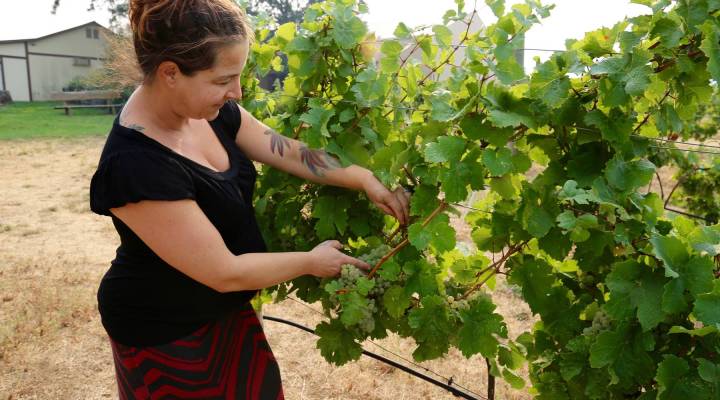
Smoke from this season’s wildfires is worrying West Coast winemakers
Smoke from this season’s wildfires is worrying West Coast winemakers

On a clear day, Jocelyn Bentley-Prestwich can see major local landmarks, like the Columbia river and Mount Adams, from the vineyard she works at in Hood River, Oregon. But for awhile this summer, she had difficulty seeing to the end of her property line, thanks to smoke from the Eagle Creek fire along the Columbia River Gorge, about 20 miles away.
“The first couple of days, you couldn’t even see past those trees,” Bentley-Prestwich said as she points a couple yards away to the trees that line the perimeter. She’s the marketing manager of the seven acre Cathedral Ridge Winery.
The fire covered thousands of acres at its peak and, at one point, even halted commercial boat traffic on the river.
Outside on the vineyard, Bentley-Prestwich showed me a row of Riesling grapes ripening on the vine. She put one in her mouth, testing it for ripeness.
“Still a little tart, but they’re good,” she said, estimating another week until the grapes are ready for harvest.
The taste is an important factor. All the smoke and ash hanging in the air could easily transfer to the grapes, potentially changing the quality of the wine.
“When you have this much smoke in the air, you have complete climate change: it’s cooler, the atmosphere is different,” Bentley-Prestwich explained. “If it’s hazardous for us to breathe, you can only imagine what’s happening when it falls on the leaves and the grapes.”
Bentley-Prestwich tells me the effects of wildfire smoke are being debated in wine circles across the west coast, and has been the subject of several roundtable discussions with local wineries, including one organized by the Oregon Wine Board in early September.
“This is a huge thing for the wine industry because Oregon and Washington have these major wine industries. This is something everybody is taking very seriously,” she added.
Two-thirds of all wine produced in the country is grown in California, Oregon and Washington and the industry raked in more than $38 billion in U.S. wine sales last year. But with wildfires becoming all too common, some growers are turning to science for help.
“There’s concern all up and down the west coast with the fire intensity that we’re seeing,” said Thomas Henick-Kling, the director of the Viticulture and Enology department at Washington State University.
Henick-Kling’s department is the only one in the country leading research on what happens when grapes are exposed to smoke for extended periods of time. He said more often, they develop a certain taste or smell called smoke taint.
“These wine taints are described as sometimes campfire, but also ashtray. Those aromas, of course, are not very attractive in a wine,” he explained.
This summer, wildfires have ravaged states in the American West. More than a million acres have burned in Montana, Oregon, Washington, and California. And people living in the region have been dealing with smoky conditions for weeks. And it’s happening at a time when vineyards are preparing to cash in on their crops.
“Wine is a delicate business because you only have this window once a year to make your product,” said Michael Kaiser, vice president of Wine America, a national trade association that advocates for the wine industry.
“It’s not like beer and spirits, where they’re able to make their products all year round,” he added. “It’s now or never for the year.”
And while there are plenty of powerhouse vineyards in the west, there are also a lot of smaller enterprises. And for them one bad harvest could mean a significant hit to the bottom line.
“Every vintage, you want that to be the best it can,” said Scott Steingraber, president of the Southern Oregon Winery Association and co-owner of Kriselle Cellars in White City, Oregon. “Your reputation relies on a consistent mark of excellent wine.”
And, he added, it’s not something winemakers can afford to ignore. With climate scientists predicting that hotter, dryer summers are the new normal, vineyards will have to be prepared.
| How do wineries set the price for a bottle of wine? |
| How small businesses are affected by wildfires |
There’s a lot happening in the world. Through it all, Marketplace is here for you.
You rely on Marketplace to break down the world’s events and tell you how it affects you in a fact-based, approachable way. We rely on your financial support to keep making that possible.
Your donation today powers the independent journalism that you rely on. For just $5/month, you can help sustain Marketplace so we can keep reporting on the things that matter to you.


















